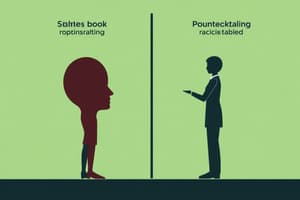Podcast
Questions and Answers
Which model suggests that managers must operate with intuition and judgment due to the limits of rationality?
Which model suggests that managers must operate with intuition and judgment due to the limits of rationality?
- Bounded rationality model (correct)
- Political model
- Escalation of commitment model
- Rational model
What characteristic of groupthink refers to the group's belief in their own superiority?
What characteristic of groupthink refers to the group's belief in their own superiority?
- Pressures toward uniformity
- Goal displacement
- Overestimation of the group (correct)
- Close-mindedness
What is a primary disadvantage of group decision-making?
What is a primary disadvantage of group decision-making?
- Greater pool of information
- Increased intellectual stimulation
- Longer decision-making process (correct)
- Varied perspectives and approaches
In which model do self-justification and preservation play a significant role in continuing a failing course of action?
In which model do self-justification and preservation play a significant role in continuing a failing course of action?
Which type of power is NOT a source of influence in the political model?
Which type of power is NOT a source of influence in the political model?
Which technique can improve group decision-making by allowing individuals to contribute ideas anonymously?
Which technique can improve group decision-making by allowing individuals to contribute ideas anonymously?
Which of the following is NOT a characteristic of groupthink?
Which of the following is NOT a characteristic of groupthink?
Which advantage of group decision-making can lead to a potential disadvantage due to conflicting priorities?
Which advantage of group decision-making can lead to a potential disadvantage due to conflicting priorities?
What distinguishes programmed decisions from non-programmed decisions?
What distinguishes programmed decisions from non-programmed decisions?
What is the first step in the decision-making process?
What is the first step in the decision-making process?
Which of the following best describes 'discount the future' as a psychological barrier?
Which of the following best describes 'discount the future' as a psychological barrier?
In what decision-making condition do managers possess complete knowledge of outcomes?
In what decision-making condition do managers possess complete knowledge of outcomes?
Which approach to decision making is characterized by gathering facts and assessing evidence?
Which approach to decision making is characterized by gathering facts and assessing evidence?
Which of the following is not a step in the decision-making process?
Which of the following is not a step in the decision-making process?
What is a key characteristic of non-programmed decisions?
What is a key characteristic of non-programmed decisions?
What does time pressure represent in the decision-making context?
What does time pressure represent in the decision-making context?
Flashcards
Programmed decisions
Programmed decisions
Well-structured, routine decisions with readily available information, using established rules and procedures. Short-term focus.
Non-programmed decisions
Non-programmed decisions
Poorly structured, new decisions with limited information, requiring judgment and creativity, typically long-term.
Decision-making conditions
Decision-making conditions
The level of certainty or uncertainty surrounding the available information when making a decision. Ranges from certainty to risk to uncertainty.
Decision-making process (steps)
Decision-making process (steps)
Signup and view all the flashcards
Illusion of control
Illusion of control
Signup and view all the flashcards
Discounting the future
Discounting the future
Signup and view all the flashcards
Rationality in decision making
Rationality in decision making
Signup and view all the flashcards
Decision-making conditions
Decision-making conditions
Signup and view all the flashcards
Rational Model of Decision Making
Rational Model of Decision Making
Signup and view all the flashcards
Bounded Rationality
Bounded Rationality
Signup and view all the flashcards
Political Model of Decision Making
Political Model of Decision Making
Signup and view all the flashcards
Escalation of Commitment
Escalation of Commitment
Signup and view all the flashcards
Group Decision Making Advantages
Group Decision Making Advantages
Signup and view all the flashcards
Group Decision Making Disadvantages
Group Decision Making Disadvantages
Signup and view all the flashcards
Groupthink
Groupthink
Signup and view all the flashcards
Improving Group Decision Making
Improving Group Decision Making
Signup and view all the flashcards
Study Notes
Decision Making
- Decision making involves selecting the best course of action from various options
- Two types of decisions: programmed (routine, well-structured) and non-programmed (new, unstructured)
- Decision making process (6 steps): problem identification, alternative solutions, evaluating alternatives, choosing an alternative, implementing, and evaluating.
Decision Conditions
- Certainty, Risk, Uncertainty
- Decision making conditions are the level of information available regarding alternative options and their associated outcomes.
Barriers to Good Decisions
- Illusion of control (thinking you have more influence than you do)
- Discounting the future (prioritizing immediate over long-term outcomes)
- Time pressures
Rational Model
- Assumes decision-makers are perfectly rational, objective, & possess complete information.
- Aims to select the optimal alternative to achieve organizational goals.
Bounded Rationality Model
- Recognizes that perfect rationality is unrealistic.
- Managers make decisions based on limited information and cognitive limitations.
- Aims to achieve satisfactory solutions instead of optimal ones.
Political Model
- Acknowledges the impact of power dynamics and politics on decision making.
- Factors like influence, negotiation, and competing interests affect outcomes.
Escalation of Commitment
- The tendency for people to persist with failing courses of action, even when it's not the best choice.
Group vs Individual Decision Making
- Groups can offer diverse perspectives and information, potentially leading to better decisions.
- Groups can also suffer from biases (e.g., groupthink) that discourage creative solutions.
Studying That Suits You
Use AI to generate personalized quizzes and flashcards to suit your learning preferences.




